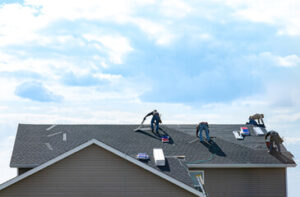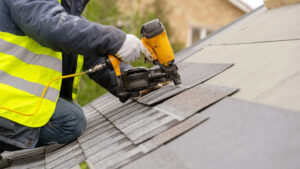Commercial roofers inspect, repair, and install roofs on commercial establishments. They also conduct regular maintenance to extend a building’s lifespan.

Commercial roofing is more complex than residential roofing and requires specific qualifications to perform properly. Visit Website to learn more.
Professional commercial roofers are experienced in working on different types of roofing materials, including metal, shingles, and single-ply membranes. They have the knowledge to identify the best roofing material for a particular structure, and they are trained in safety procedures. They also know how to work with various tools and equipment. In addition, they can help you find high-quality roofing materials at wholesale prices.
Unlike the general public, commercial roofers have to follow strict building codes and regulations. They are also required to wear safety gear at all times, which ensures that their work is done properly and without a hitch. Professional roofers will always comply with these regulations, and they can provide you with detailed quotes for your project. They can also help you navigate the complexities of local building codes.
A skilled commercial roofer will be able to correctly identify and address minor issues that can lead to severe problems in the future. This will save you money in the long run and improve your building’s longevity. They also offer warranties on their services, and this can give you peace of mind.
While a career in commercial roofing can be lucrative, it requires a lot of time and effort. It is important to choose the right training program to become a competent roofer, and it is also essential to be physically fit. This is because you will be spending a lot of time on the job, and you will need to climb up and down ladders. You will also need to be able to handle heavy loads, such as tools and roofing materials.
In order to be a qualified commercial roofer, you need to complete an apprenticeship program. This is typically a two-year program that includes hands-on experience and classroom courses. You will also learn how to read blueprints, how to perform basic troubleshooting, and how to perform preventative maintenance on buildings. In addition to these skills, you will need a strong background in math and problem-solving. In some cases, you may even need a bachelor’s degree. In general, a qualified commercial roofer will have at least five years of experience.
Experience
Commercial roofers have extensive experience working with a wide range of roofing materials, including flat and metal roofs. They are also familiar with the many state regulations that apply to commercial roofing, and they will ensure that all workers are safe throughout the process. They can even help you find a good manufacturer that offers certification for its installers. This can be important for commercial roofs Hamilton because they tend to have more complicated installation processes than residential roofs.
In addition to their knowledge of different types of roofing, commercial roofers have extensive experience with the various tools and equipment that are used to complete a job. They may also be able to work with more complex structures, such as high-rise buildings. They also have experience dealing with specific weather conditions, such as hot summers and cold winters.
The difference in skillsets between commercial and residential roofers is another key factor to consider. In general, residential roofers have less specialized skills and work with more traditional materials. Commercial roofers, on the other hand, have a much more diversified skill set and need to be familiar with a wide range of roofing materials, such as metal, asphalt shingle, PVC, and TPO.
A commercial roofer must be able to work under pressure and meet deadlines. For example, a school will often need to have its roof replaced before it opens in September. Commercial roofers need to have a system in place to quickly and efficiently get the job done without sacrificing quality.
Lastly, a commercial roofer should be comfortable with heights. It is common for them to be working on high-rise buildings that require special equipment to hoist materials and equipment onto the roof’s surface. This is especially important in cold climates where ice dams can form on the roof and cause serious water damage.
If you are looking for a rewarding career, you should consider becoming a commercial roofer. Although it is a physically demanding job, it can be very satisfying to see your work come to life. In addition, it is a great way to get out of the office and into the outdoors every day.
Licenses
The licensing requirements of commercial roofers vary from state to state. Generally, they involve showing previous experience in the trade, passing an exam and obtaining insurance. In some instances, a bond is required to obtain a license. In addition, a number of municipalities have their own requirements that must be met to perform roofing work.
Generally, commercial roofers must have the proper skills to repair or replace all types of roofing materials. These include EPDM rubber, PVC, hot tapered systems and standing seam. They must also be able to inspect the roof surface, gutters and drainage system. In addition, they should have the stamina to work outdoors for long periods of time and be able to communicate with clients to understand their expectations.
In Alaska, roofing professionals need a specialty contractor license to perform any work that exceeds $15,000 in value. This is administered by the department of labor and industry, and requires a trade exam, two years of work experience and proof of insurance. However, in the case of residential roofing, the state does not require a license.
If you’re a roofing contractor, you must register as a Home Improvement Contractor (HIC) with the Office of Consumer Affairs and Business Regulation. This enables consumers to file complaints against unlicensed contractors, and ensures that roofing professionals have liability insurance, workers’ compensation coverage and a bond.
Most states require a roofer to obtain a license at the state level. In some cases, this is only for general roofing, while other states require a specific license for commercial roofers. In these cases, the state will often require roofing contractors to pass a trade exam, provide Proof of insurance and in some instances post a bond before granting them a license.
Insurance
Roofing is a dangerous profession, so commercial roofers have to carry extra insurance policies in addition to workers’ compensation and general liability. These extra policies can include a surety bond and professional errors and omissions insurance. These policies protect the contractor in case a customer accuses him or her of a mistake or oversight that caused financial loss. Some insurers even offer a business owners policy that bundles three types of coverage into one package for contractors, according to Forbes.
General liability insurance protects roofers in the event that a third party is injured by the company’s work, tools or equipment. This type of policy can cover medical expenses, legal fees and damage to property. In addition, it often includes general property insurance that covers the cost of repairing or replacing tools and equipment that are stolen or damaged on the job. A good roofing insurance policy also has a worker’s compensation component that pays for lost wages if a roofer is injured at the workplace.
Errors and omissions insurance is another important policy for roofers, as it protects them from claims made by customers due to mistakes in their service. This can include faulty advice, failure to perform a certain task, or other similar issues. It’s important for a roofer to have this policy, because it protects him or her from expensive lawsuits that could ruin the reputation of the business and lead to financial ruin.
Commercial auto insurance is also a must for roofing professionals, as it protects the business in the event of an accident involving a company vehicle. This type of policy can cover the costs of repair or replacement for company vehicles as well as legal fees if an employee is at fault for an accident. In addition, this type of policy can also cover the cost of a rental car if the roofer needs to use one while working on a project.
A good roofing insurance provider can help you decide what types of coverage are right for your business. They can also help you choose the best deductibles to keep your premiums low and recommend a wide range of safety and business-related coverage options.






